Buy online, pick-up in-store (BOPIS) was already an established means of shopping pre-pandemic. However, as COVID-19 accelerated in March of 2020, so did BOPIS. All industry and consumer behavior data indicate that buy online pick-up in-store is going to have staying power far beyond the end of the pandemic.
This has driven retailers to reexamine how they utilize their facilities, for both the shopping experience as well as product inventory. As stores pivoted to pick-up models, they had to redesign their storefront spaces and examine how they conduct their e-commerce business, as they also had to adjust to a more omnichannel approach.
These changes have led to new operational challenges, the need for more warehouse space, and making sure inventory is accurate. Maintaining and managing warehouse facilities have become increasingly critical.
BOPIS, Dark Stores and Warehousing During the Pandemic
While facilities began implementing curbside pick-up and other BOPIS services to abide by state and national regulations, they also worked to create a more comfortable experience for those customers who preferred to keep in-person contact at a minimum. Now, as we slowly make our way to the other side of a global pandemic, BOPIS continues to be a highly popular, and in some cases, the preferred type of shopping experience for many customers. In fact, a survey conducted by Forbes in May 2021, several months after wide availability of vaccines and onsite locations fully reopened for business, found that more than a third of respondents had used BOPIS within the past month.
Additionally, American consumers spent $72.46 billion via click-and-collect in 2020, according to Insider Intelligence, which accounted for 9.1 percent of all e-commerce. Those figures are estimated to increase to $83.47 billion and 9.9 percent in 2021.
On the delivery side of the table, warehousing also became increasingly important, as many retailers moved their fulfillment centers closer to the end-user. This allowed them to rely less on third-party delivery services and focus more on last-mile delivery. Consumers demanded same-day or next-day delivery, so making this pivot proved essential for retailers to meet their customers’ expectations.
Some retailers took an even more creative approach when it came to using their physical locations to adapt to the pandemic and the shift in consumer behavior. Another method that became popular during this period was “dark stores.” This is where a retailer uses their closed retail space and turns it into a quasi-warehouse to store products for this new e-commerce and omnichannel model. Bed, Bath & Beyond even made plans to convert 25 percent of its retail stores into regional fulfillment centers.
How Vixxo Can Help Manage Retail Facilities and New Operational Challenges
So what does this shift in the markets and customer buying behavior mean for retail facilities? With the increase in warehousing, retailers will need to make sure they have a solid plan for how they can configure their sites to meet their new operational challenges. As a facilities management leader, Vixxo can provide expertise and guidance with a suite of solutions to solve any challenges current retail facilities face with the new and ever-evolving consumer landscape.
By outsourcing facilities maintenance and capital projects, retailers can focus on staying ahead of their competition. We use our extensive network of local service providers to schedule maintenance, installation, and construction tasks in a timely, efficient manner. We also provide reporting, documentation, data, and analytics to help assess your maintenance program and identify opportunities for process improvements.
To learn more about Vixxo’s facility maintenance and project capabilities for retailers, visit vixxo.com/industries/retail.




